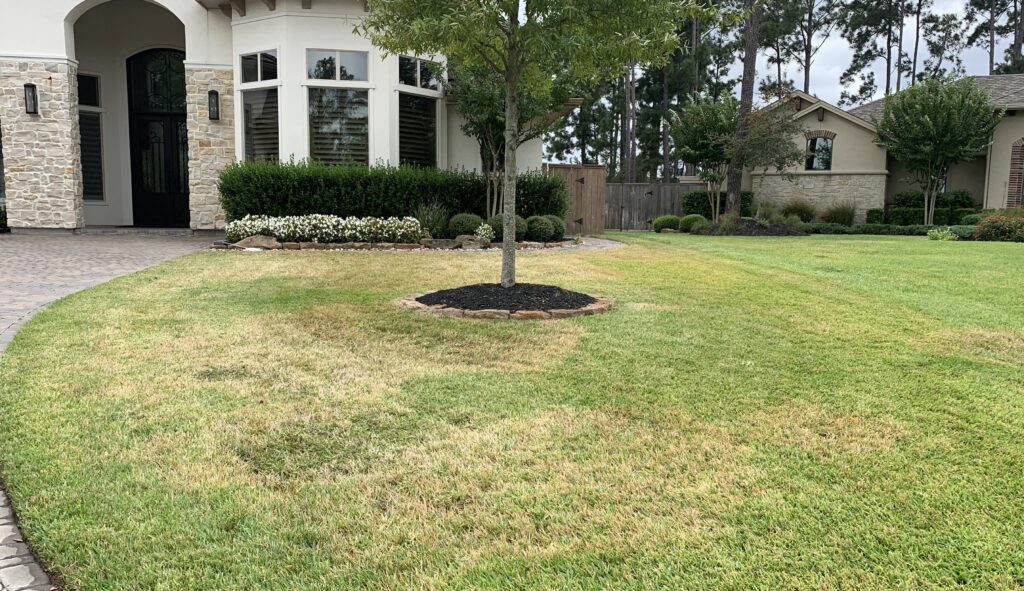Yard Fungus Control Services in the Greater Houston Area
National franchise and discount companies may give the nod and a wink to yard fungus outbreaks, but GreenGate Turf has labeled yard fungus public enemy number one. Most fungus spores lay in wait within the thatch layer between your soil and the grass, ready for perfect growing conditions. (Typically over watering with cool evenings in spring & fall) So we take the fight directly to the fungus spores.
How does it work?
Our 3 step program aggressively keeps thatch in check while simultaneously showering spores with Rhizobacteria and our Biological Inoculants that eat and destroy fungus-causing pathogens. Our three applications encourage and support the lawn’s healthy ecosystem, helping the grass defend itself against pathogen outbreaks.

GreenGate’s guaranteed 3 Step Fungus prevention & maintenance program is a cost-effective way to prevent expensive fungus damage to your turf. Our program includes Gray Leaf Spot, Brown Patch Fungus, and other common lawn fungi in our region.
This program does not include soil-borne pathogens such as take-all-patch. Contact our office today for our treatment options for take-all-patch, also known as take all root rot.
WHAT TO EXPECT with Gg's yard fungus program
Ready to get started? Here’s what you can expect from our award winning services:
- An email 48 hours before your scheduled lawn fungus treatment service
- An email & text 24 hours before your scheduled service
- A text while in route to your property
- A post-visit email letting you know what we did
LAWN FUNGUS CONTROL FAQ
The most common lawn fungus types we see in Houston, TX are brown patch fungus, grey leaf spot fungus, and take all patch*.
For take all root rot, or take all patch, please contact our office for treatment options.
Lawn fungus is usually triggered by a mix of environmental factors rather than just one issue. Most fungi already exist in your lawn’s thatch layer, lying dormant until conditions are right. Common causes include:
Overwatering or poor drainage – too much moisture creates the perfect breeding ground.
Cool, humid evenings in spring and fall – fungus thrives when grass stays damp overnight.
Compacted soil and heavy thatch – these limit airflow and trap moisture.
Stressed grass – from dull mower blades, too much shade, or improper fertilization.
When these conditions line up, dormant spores can quickly spread, leading to visible patches or discoloration in your lawn.
Look for discolored patches, unusual rings, powdery or slimy growths, or rapid thinning. Different types of fungus show up differently, but all indicate your lawn is under stress.
Yes! Proper mowing, watering in the morning, reducing thatch, and maintaining a healthy lawn ecosystem can help prevent fungus outbreaks. Our program is heavily focused on giving your lawn the rhizobacteria it needs to eat and destroy the pathogens that create fungus in the first place.
Lawns that are overwatered, have poor drainage, heavy shade, or compacted soil are more prone to fungus. Healthy, well-maintained lawns are naturally more resistant.
Some treatments are safe for homeowners, but many require professional expertise to be effective. Targeted applications of beneficial microbes and biological inoculants work best when applied by trained professionals.
Results vary depending on the type of fungus, severity, and lawn conditions. With a proper treatment plan, many lawns see improvement within weeks, while long-term prevention requires ongoing care.
We like to think of it like growing out a bad haircut. Once the fungus is killed off/inactive, the lawn has to grow out the brown patches in order to be cut off by regular mowing.
Yes, if conditions remain favorable for spores, such as overwatering, fungus can reappear. That’s why ongoing maintenance, proper watering, and regular applications of beneficial microbes are important.
Different grass types have varying susceptibility. Some are more resistant, but most common turf grasses, like Houston’s St Augustine, Bermuda, and Zoysia, can experience fungus if conditions are right.
